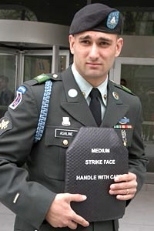An infantryman who survived a blast from an AK-47 in Afghanistan in 2002, thanks to his bulletproof vest, presented himself as an example of how high technology can save soldiers' lives at the dedication of MIT's Institute for Soldier Nanotechnologies (ISN).
"If it weren't for technology I wouldn't be standing here today," said Specialist Jason C. Ashline of the U.S. Army 10th Mountain Division. "Thank you for having me here today. Thank you for protecting our soldiers."
The ISN, a $50 million research collaboration between the United States Army and MIT, aims to enhance the protection and survival of soldiers using nanotechnology. Ashline was one of several speakers from MIT, the Army and industry at the May 22 event, which was capped by a rousing sing-along of the official Army song, "The Army Goes Rolling Along" (the words were in the program). A five-piece Army brass band added to the festivities.
Ashline was hit twice in the chest during a 12-hour firefight with Al Qaeda on March 2, 2002. The slugs lodged in his body armor. Ashline, 20 years old at that time, told the Daily News in New York: "For a couple of seconds, everything was, like, in slow motion. I was pretty scared because I didn't feel no pain. I thought, 'What's wrong?' I thought maybe I was dead."
He was stunned but unhurt, and was pulled to safety by his buddies. Ashline received the Army Commendation Medal and has re-enlisted for four years. "My vest saved me from a trip to the morgue," Ashline said.
The ISN "offers MIT a historic opportunity to contribute to the well-being of our country," said MIT President Charles M. Vest. MIT has never been an "ivory-tower university," he said, but has always focused on real-world applications.
Cambridge Mayor Michael A. Sullivan agreed with Vest, eliciting chuckles when he said, "This certainly is no ivory tower. Just look at what they build around here," referring to the distinctive design of the Stata Center, currently under construction.
The dedication included tours of the ISN's new facility at 500 Technology Square, complete with displays of ongoing research. One team, for example, is creating nanoscale fabric coatings a few molecules thick that kill bacteria and keep the wearer dry. A cotton T-shirt treated with such a coating would be indistinguishable in look and feel from untreated fabric. Another group explained their work investigating fluids that stiffen when exposed to a magnet for use as a dynamic armor system.







